You may have discovered a navigation light had crapped out when you recommissioned your boat this spring. Or, you’d like to shed a little more light on the engine room. Now is the time to swap the old-school bulb variety with light-emitting diodes or LEDs. By doing so, you can save amps, boat longer and avoid changing light bulbs, maybe forever. Change only the tunes and let the stereo amp eat the juice — it’s far more fun.
LEDs are electronic devices. By manipulating frequencies using electronics, any LED can be made to emit a variety of colors. New technology has made them more efficient than ever before, reduced the heat that once caused failure, and stopped the electronic interference that plagued boaters who used them.
Most of the LEDs we tested were sealed from moisture and corrosion — both benefits that spell more boating fun and fewer headaches.
How We Tested
–We tested current draw from a fully charged 12-volt battery using a digital multimeter. On average, all the lights we tested drew 90 percent less power than a comparable incandescent.
–To capture lux/lumens, we used an industrial light meter and converted to candelas to confirm that light emission met minimum specifications. Some lights were considerably brighter. Green sidelights were consistently brighter than red.
–Our formula for candela conversion is Lux x Distance Squared = Candelas. Coast Guard minimum is 4.3 candelas.
–LEDs are electronic devices and are subject to rules that limit radio wave interference. We operated the lights in contact with an Icom M24 VHF radio and an AM transistor radio antenna to check for interference. None of the lights in our test produced detectable radio frequency interference, though the Livorsi lights did create a mild static effect on an AM radio, but only when the fixture touched the antenna.
–All the lights we tested used corrosion-resistant tinned wire.
–All test lights survived our dunk test while illuminated.
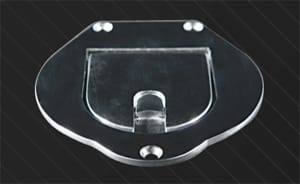
Accon Marine
211-M Pop Up
This pop-up combination light sits flush on the deck at the centerline, eliminating an anchoring hazard and streamlining the hull appearance until deployed.
Cool Feature: It includes a surge protector, also potted against moisture intrusion, mitigating the most common cause for LED lights’ rare failure.
Hardware Included: None; use sealant instead of gasket.
Cost: From $150
Candelas: Green 26.1, Red 14.2
Light Intensity at 6 Inches: Green 500 lumens, Red 310 lumens
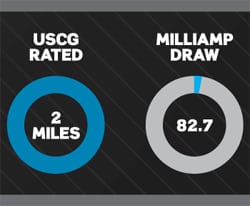
Combo and Separate Sidelights
Sidelights must be visible from dead ahead to 22.5 degrees abaft the beam and produce at least 4.3 candelas of light to meet their rating. They can be mounted under the sheer line or above, on any structure, as long as the arc of illumination is correct and they are at least one meter below the stern light. Lights below the sheer line must meet a higher submersible standard for water resistance than lights above the sheer. Technically the red and green sidelights should never be visible at the same time, but they often are — especially in combo sidelights.
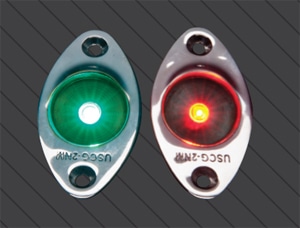
Livorsi Marine
LEDNLG2 G and R
These stainless-steel fixtures are solid, potted and submersible with tinned wire. They were among the brightest and most efficient we tested.
Cool Feature: There are no bezels to break. Single LEDs are recessed in the stainless-steel fixture.
Hardware Included: None
Cost: $76 each
Candelas: Green 28.5, Red 14.2
Light Intensity at 6 Inches: Green 1,780 lumens, Red 870 lumens
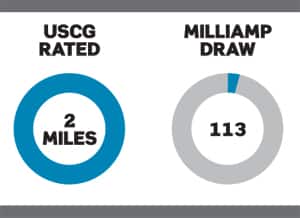
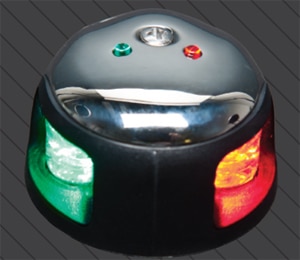
Attwood Corp.
3520
Combo lights are of plastic with clear plastic bezels and a chrome/stainless-steel top.
Cool Feature: Telltale lights on top allow captain to confirm operation from the helm without going forward to check.
Hardware Included: Gaskets; no screws
Cost: $44.96
Candelas: Green 21.4, Red 16.6
Light Intensity at 6 Inches: Green 650 lumens, Red 500 lumens
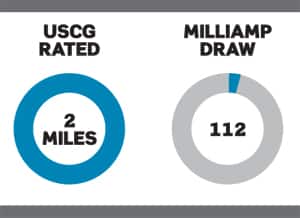
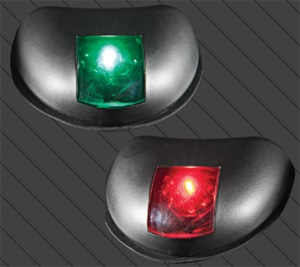
Perko Inc.
0617DP0BLK
Stealth Series low-profile sidelights are delta-shape with flat black for a sleek, aggressive look.
Cool Feature: They are water-resistant but not submersible, and not potted, but still remained illuminated in our dunk tank test.
Hardware Included: Gasket; no screws
Cost: $233/pair
Candelas: Green 30.8, Red 21.4
Light Intensity at 6 Inches: Green 850 lumens, Red 580 lumens
* for boats under 37.5 feet
_
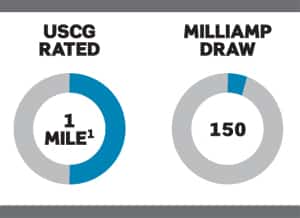
_
_
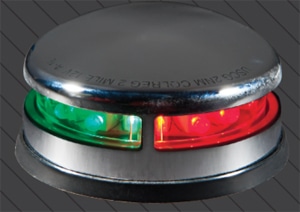
_
SeaSense Marine Products
50023875
Low-profile stainless-steel housing is fitted with extremely bright LEDs, and the electronics are potted.
Cool Feature: This was our lowest-draw combo light. Electronics are watertight.
Hardware Included: Gasket and stainless-steel screws
Cost: $79.99
Candelas: Green 16.6, Red 9.5
Light Intensity at 6 Inches: Green 1,000 lumens, Red 630 lumens
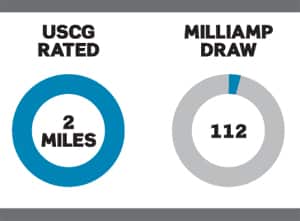
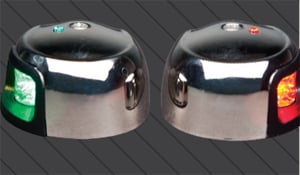
Attwood Corp.
3530 R and G
Sidelights feature the same construction technique as on the combo lights but have individual red and
green lights.
Cool Feature: Telltale light on top of housing is visible from the helm to reassure the captain that they work.
Hardware Included: Gaskets; no screws
Cost: $34.96 each
Candelas: Green 18.9, Red 16.6
Light Intensity at 6 Inches: Green 470 lumens, Red 500 lumens
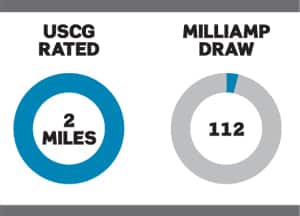
Removable Stern Lights
These lights must be positioned at least one meter higher than the sidelights and be visible for an arc of 360 degrees.
Tip: Some brands, but not all, are compatible with competitors’ light base/socket. When replacing them, be sure of compatibility.
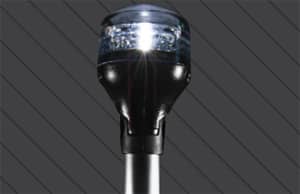
Attwood Corp.
5530 Series
This 24-inch stern light has an articulating head, enabling the ideal horizontal orientation of the light when mounted on slanting decks.
Cool Feature: Articulating light allows easy horizontal adjustment, compensating for mounting the pole on a slanted deck.
Hardware Included: Base and screws are optional.
Cost: $39.96
Candelas: 21.4
Light Intensity at 6 Inches: 770 lumens
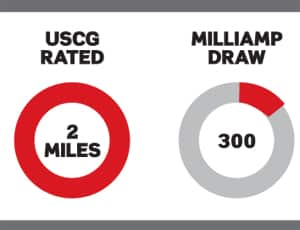
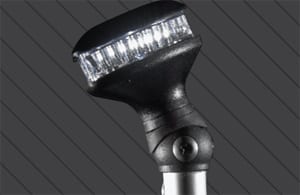
Perko Inc.
Stealth Series 1347
The 24-inch fixture is delta-shape and sleek, and because it’s articulating, can be easily adjusted to compensate for mounting on a slanted deck.
Cool Feature: It comes with two mounting collars, allowing it to serve as a replacement light for several other brand bases.
Hardware Included: Base and screws are optional.
Cost: From $99
Candelas: 21.4
Light Intensity at 6 Inches: 700 lumens
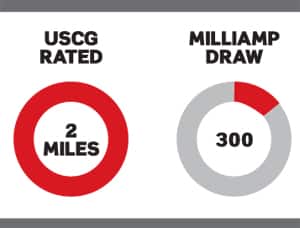
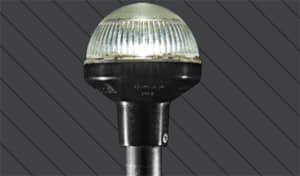
SeaSense Marine Products
50023961
This hemispherical globe light casts an even light all around, giving appropriate 360-degree coverage even when mounted on slanted decks.
Cool Feature: It is telescopic, making it easy to adjust to optimum height and easy to stow.
Hardware Included: Base and screws are optional.
Cost: From $54.99
Candelas: 23.7
Light Intensity at 6 Inches: 850 lumens
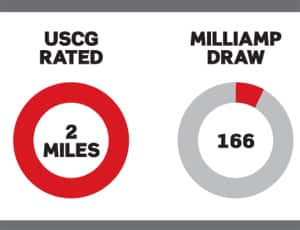
Courtesy Lights
Courtesy lighting, especially red, white or amber colors, mounted in such a way as to be confused with navigation lights can be dangerous. So, mount them low in the cockpit and in places where lighting is indirect for best results.
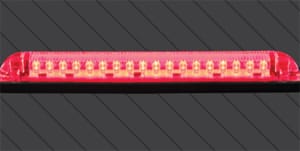
SeaSense Marine Products
50023787
These strip lights are powerful but draw only a fraction of an amp, so using them, even at anchor, won’t overdraw the battery banks.
Cool Feature: They are submersible as well, so they can be mounted on the hull for ambient lighting at anchor.
Hardware Included: Gasket and stainless-steel screws
Cost: $18.99
Candelas: 18.9
Colors Available: Blue, green, red, yellow, white
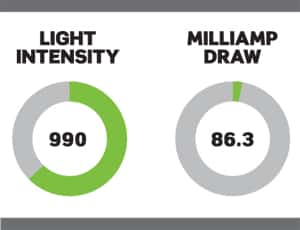
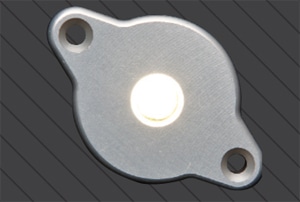
Livorsi Marine
LED Courtesy
This stainless-steel fixture features potted electronics and no bezel to replace. The ultrabright LED makes an ideal engine-room or companionway light.
Cool Feature: It’s made of solid construction and has no bezel to replace.
Hardware Included: None
Cost: $76
Candelas: 30.8
Colors Available: White, red, green
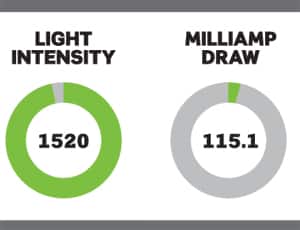
Glossary
Milliamp: One-1000th of an amp. Most LED navigation lights burn 80 to 100 milliamps, or about one-10th or less
than what an incandescent light burns.
Candela: An English standard measure of light intensity. We converted lux/lumens to candelas.
Two-mile lights: Most navigation lights are certified to give a certain intensity at two nautical miles to meet United States Coast Guard standards. Lights that emit 4.3 candelas at 16 feet meet this test.
Sidelights: These are the red or green lights placed on the hull or other structure in a way that they illuminate 112.5 degrees from dead ahead to just aft of the beam. They should not both be visible at once — even from a nearly dead-ahead orientation to the viewer.
Submersible lights: All lights mounted below the sheer line must be submersible to Coast Guard/ABYC specs.
10 Tips for Proper Installation of Courtesy Lights
1. Red, green, yellow and white are navigation lighting colors, so be sure to mount them beneath the gunwales or inside recesses that prevent the fixture from being visible outside the boat.
2. Chart lights on the helm should be shaded so the light element is not visible. Only the helm and charts should be softly illuminated.
3. Overhead courtesy lights should be recessed in sockets or fixtures and covered with a “fogged” bezel to eliminate harsh reflections that could imitate navigation lights.
4. White courtesy and companionway lights should be mounted close to the deck or sole to illuminate only the deck or companionway.
5. All electrical connections should be fused and fastened with heat-shrink connectors.
6. Support wires appropriately, fastening them about every 12-inches — don’t leave dangling, slack wire.
7. Don’t gang too many LEDs together. Six or so low lux courtesy lights are enough on a circuit. Any more and they may not have enough power to illuminate at all.
8. Circuit breakers protect the boat’s wiring; fuses protect the device. Use the former to protect from shorts and the latter to protect the device from power surges.
9. Use a wire stripper, not a pocketknife. Blade nicks on the wire reduce the carrying power of wire.
10. Don’t combine LEDs and electronics on the same circuit. Even though LED electronics are interference suppressed by FCC rules, don’t tempt fate and hook them to a stereo or VHF power point.








